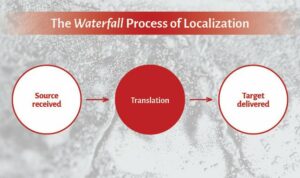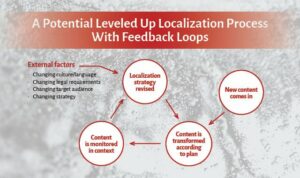Language services play a crucial role in connecting businesses with diverse audiences across linguistic and cultural barriers. However, the typical service that language service providers (LSPs) offer falls short of addressing the complex needs of businesses as they are often solely focused on linguistic aspects. It is time for language services to level up and redefine their approach to meet the evolving demands of the outside world.
Not Just Language
Traditionally, LSPs have focused on offering translation as their primary service. While translation is undoubtedly at the heart of our services, it does not provide complete solutions to the problems that businesses face before they can effectively communicate with global audiences.
If you look around, you’ll see LSPs of all sizes continuously reiterate how language and translation are more complex than people think and that therefore only they can offer the expertise needed. However, from an outside perspective, this narrative is in stark contrast to the ‘complexity’ of the actual service they offer: “send me a file and I’ll send you a translation back in X days while it costs you Y cents per word”. How can a client believe in an LSP’s narrative if it’s the same as the narrative of 10.000 other companies while it only differs on X and Y? This is the perfect recipe for a race to the bottom.
In an increasingly competitive landscape where machines provide a similar service, ‘translating a file’ will be perceived as a less and less valuable service offering. That is the true strain, risk, and effect machines have on the localization industry: the diminished perceived value of translation. In this regard, I feel that many LSPs are asleep at the wheel. We merely pride ourselves on being good with languages but we are not making any effort to broaden our actual service offering.
Changing the Service
To break free from the race to the bottom based solely on pricing, LSPs must redefine their role and embrace a more comprehensive service model. Rather than treating language services as a transactional process, LSPs should position themselves as trusted consultants and advisers. By taking a proactive role in understanding the linguistic assets of clients, implementing bespoke and efficient translation processes, and leveraging technology, LSPs can deliver a service that goes beyond translation and adds tangible value.
Language is so many things: always changing, situational, local, cultural, and even legal. The environment in which linguistic content lives fluctuates: new laws are implemented, wording changes because of cultural shifts, even client strategies and target audiences change. How should linguistic assets change over time based on changes in their context and environment? These are some of many interesting complexities of language that I simply do not see addressed by the service LSPs offer today. That is because the process we adhere to is by definition finite and momentary in time. We offer you a translation and we don’t look back (in software development we call this waterfall). That’s such a huge waste of opportunity! Instead, you could offer to take care of a client’s linguistic assets, manage them, and offer bespoke services based on the client’s budgets and needs. Advice, consult, use analytics data to validate and change strategy, go the extra mile. Use your linguistic and cultural expertise to monitor and apply changes to previously translated content when necessary. That’s when you offer a real service that hopefully also removes the need for the per-word pricing paradigm we have been stuck with. You will offer what I see as real Language Operations so that your client can focus on what they do best.
Language = Technology
The most significant reason many LSPs are currently not able to provide these kinds of services is because they often lack a conscious strategy for addressing the technical aspects of the translation process. As a result, clients are left to handle the extraction, processing, and delivery of linguistic content by themselves, leading to inefficient and disjointed workflows.
The reality is that most linguistic content that is handled by an LSP lives in some kind of software system owned by the client. If you want to consult on, own, and control the process of extracting and processing this content then you need to come in with a confident technology strategy. Technology shouldn’t be something that you use as a tool while you focus on language. Providing language services is providing a technology service. They are simply intertwined. The beauty of this industry is that we have to interact with all industries and companies from all sectors. And given that every single one of them is different means that you need to offer a technological solution that still fits each client perfectly.
 Having worked with many LSPs, I’ve seen that there often is no such conscious strategy to tackle this problem. Usually, a very passive attitude is taken: whatever the client thinks is most convenient we should adapt to. And this is how we end up with clients emailing us documents every week. It’s not the client’s business to actively come up with a solution to this, it is the LSP who should take a consulting role, acknowledge that there are technical aspects to the translation process, advise and implement solutions that heavily benefit the client (and of course the LSP as well) since linguistic content can be served quicker, with more accuracy and cheaper. That is a service that clients would significantly benefit from and would want to pay for.
Having worked with many LSPs, I’ve seen that there often is no such conscious strategy to tackle this problem. Usually, a very passive attitude is taken: whatever the client thinks is most convenient we should adapt to. And this is how we end up with clients emailing us documents every week. It’s not the client’s business to actively come up with a solution to this, it is the LSP who should take a consulting role, acknowledge that there are technical aspects to the translation process, advise and implement solutions that heavily benefit the client (and of course the LSP as well) since linguistic content can be served quicker, with more accuracy and cheaper. That is a service that clients would significantly benefit from and would want to pay for.
Improving the Process
The current waterfall approach to language services, where source content goes in and translated content comes out without revisiting or optimizing the process, is no longer sufficient. LSPs must shift their mindset and adopt a more holistic approach that acknowledges the complexities of language outside of their limited time engaging with it.
Your client most likely doesn’t actually want a translation, they want to have their linguistic assets reach a wider international audience. This is because they have a business reason to do so and their assets have a purpose. So you shouldn’t just implement a simple back-and-forth translation workflow, you should provide a technology solution that lets you validate how well the assets fulfill these purposes over time, and use that information to make informed decisions about the assets and the way you process them. Is the content not performing well? Perhaps switch from NMT to human translations, monitor, and repeat. Reflecting on your results and process and making improvements to it is what the software industry embraced as agile in order to level up from the waterfall methodology.
 Technology plays a vital role in reshaping the language services landscape. LSPs need to recognize that providing language services is inherently intertwined with providing a technology service. Linguistic assets are deeply integrated into various software systems, and LSPs must develop a confident technology strategy to extract, process, and manage these assets. A successful LSP should offer a technology solution that aligns seamlessly with clients’ requirements, ensuring their linguistic assets fulfill their intended purposes and reach a wider international audience.
Technology plays a vital role in reshaping the language services landscape. LSPs need to recognize that providing language services is inherently intertwined with providing a technology service. Linguistic assets are deeply integrated into various software systems, and LSPs must develop a confident technology strategy to extract, process, and manage these assets. A successful LSP should offer a technology solution that aligns seamlessly with clients’ requirements, ensuring their linguistic assets fulfill their intended purposes and reach a wider international audience.
I have seen many LinkedIn posts from LSPs that try to emphasize the values that they add. However, I must say that these are exactly the same value propositions that good linguists would add themselves, e.g. asking for style guides and glossaries, collecting reference material, and verifying the target audience and service. LSPs should offer a service that is different from what freelance linguists offer (and already do very well!): organizing and orchestrating this technical process in a way that combines multiple disciplines while providing continuous services.
In conclusion, language services providers are at a critical juncture. They must shed the outdated narrative that reduces their value to mere translators and embrace a more comprehensive and consultative approach. Because if they don’t, others will! By understanding the complexities of language, offering proactive management of linguistic assets, and leveraging technology, LSPs can redefine the industry and deliver the language services that businesses actually need.
 Hi! I’m Mathijs (/mɑˈtɛi̯s/), a software engineer, product strategist, writer, and musician. My background in theoretical computer science and philosophy drives my passion for solving complex problems.While AI tools are driving industry innovations, my interest lies in addressing challenges related to organizing ourselves, establishing seamless localization processes, and effectively managing multilingual assets in ever-changing contexts. Language is dynamic, and simply translating without revising is impractical.
Hi! I’m Mathijs (/mɑˈtɛi̯s/), a software engineer, product strategist, writer, and musician. My background in theoretical computer science and philosophy drives my passion for solving complex problems.While AI tools are driving industry innovations, my interest lies in addressing challenges related to organizing ourselves, establishing seamless localization processes, and effectively managing multilingual assets in ever-changing contexts. Language is dynamic, and simply translating without revising is impractical.
The real challenges arise in human involvement with language. I aim to assist in organizing and facilitating communication around language-related tasks. Let’s automate mundane tasks and focus on leveraging our human strengths!
Take a look at my productivity tool designed specifically for translators or read more from me on my personal blog.

